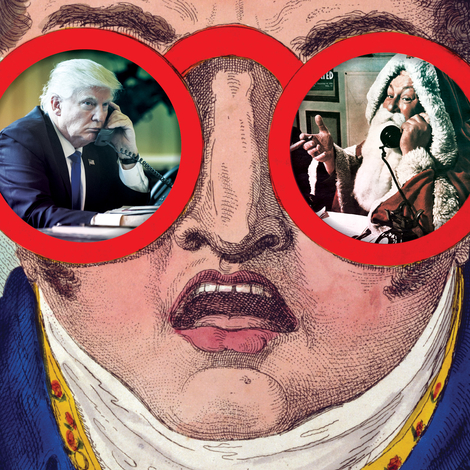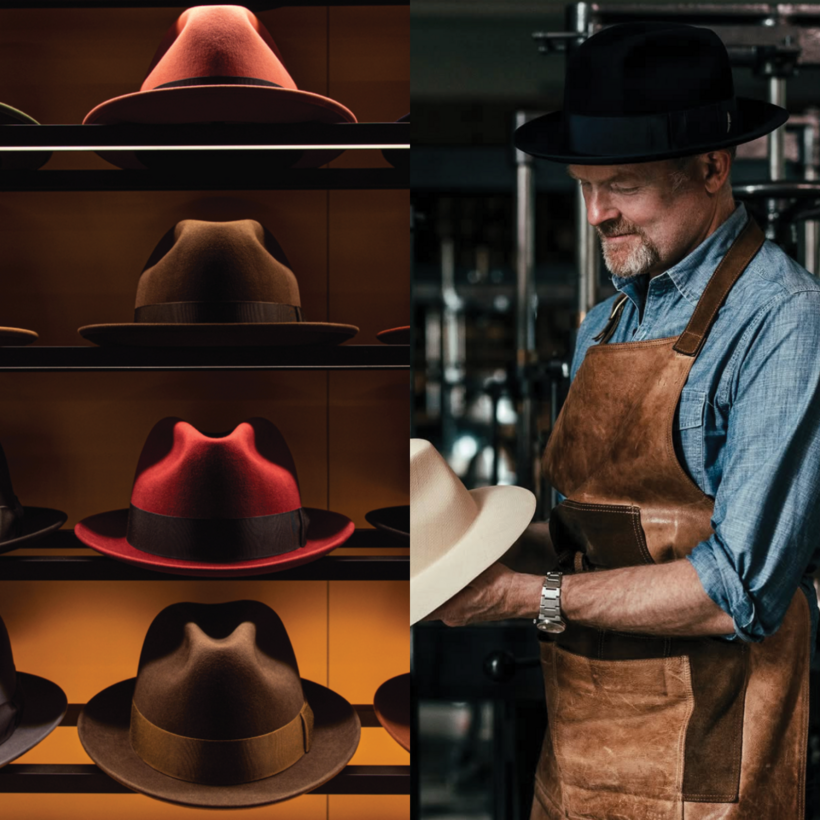An old chestnut goes that American men cast off their hats once and for all in 1961, when John F. Kennedy stood up to deliver his inaugural address with nothing atop his big auburn head to protect it from the gelid, 22-degree Washington day.
But Optimo Hats founder Graham Thompson, who probably knows more about hats than anyone dead or alive, waves this off as a specious piece of armchair history.
“The absolute peak of the global hat industry was 1914. It’s been in a nosedive ever since then. By the time J.F.K. is in office, hats have almost become a joke,” he says.

For a man who has devoted his entire life to the business, Thompson, aged 53, is quick to admit its irrelevance. History is hard to refute, after all. With the rise of the automobile, which protected travelers from the elements better than any mode of travel that came before it, the hat was reduced to little more than a stylistic flourish, not unlike spats and walking sticks. Incidentally, this is why hats held on for longer in urban centers, where people tend to hoof it more often than not.
The smart, Bogart-ish lids of the 30s and 40s, sumptuously felted and wide-ribboned, began slipping during the war, when soldiers grew more accustomed to wearing caps, giving way to cheesy postwar advertising and mass manufacturing. From there, hats devolved from a noir staple into a Madison Avenue contrivance, something you’d dare to put on your head only during a beach vacation in a far-flung country.
But on the South Side of Chicago, where Thompson has plied his trade in one form or another for more than 30 years, you would never dare to use the words “cheesy” and “hat” in the same sentence. There, the streets thrum with the sound of the blues, and echo with the pimp-walking footsteps of slick gousters—the subculture of Black youths in 60s Chicago who dressed like old-school gangsters. Their amply cut trousers concealed blades that practically had the names of hatless chumps written on them.
There’s a street there named after Thompson’s mentor: Johnny L. Tyus “The Hat Man” Ave. It was here, at 79th and Racine, that Thompson, a fervid white boy of 16 at the time, penetrated into the province of impossibly cool older Black men, pleading with Tyus, an institution unto himself on the hat-wearing South Side, to learn him in the ways of the chapeau.

“I’m like, well, I don’t have any money. And he says, ‘You can pay me every month for three years.’ And so I did that,” he says.
Thompson began his apprenticeship after college, at the age of 22. Tyus put him on a three-year payment plan for the business assets, which included vintage blocks and tools, and Thompson paid to apprentice with Tyus for seven years, until his passing. With Johnny’s Hat Shop shuttered, Thompson maxed out every credit card he could sign up for, eventually hanging out his own shingle in 1995.
When he wasn’t at the hatmaking bench, Thompson was traveling the world to learn the evanescent secrets of his craft, stumbling through Ecuadoran jungles to discover the finest Montecristi Panama straws and trawling derelict factories across Europe for outmoded hatmaking machinery.
In addition to crushing debt and the other quotidian hurdles that torment small-business owners everywhere, Thompson endured some distinctly Chicagoan rites of passage. “I had a guy pull a gun on me. He accused me of changing the color of his hat. It was probably filled with powder that we removed,” he says. “We had to fire a few customers.”

Having cleaned, re-blocked, and studied thousands of hats, Thompson observed how quality had collapsed over time and came to understand why people had stopped taking them seriously.
“You know why hats look so dumb?” he asks from under a flawlessly woven Panama with a nickel-size hole bored in the top of the crown. (Thompson mostly wears castoffs that were damaged during production.) “Imagine if everyone that was wearing a tie wore a clip-on tie. They may say, ‘Well, this is a really expensive clip-on tie. We made it out of fine silk.’ It doesn’t matter. It’s still a clip-on tie.”
Hatmaking is a dead-serious business for Thompson, whose methods are more or less unchanged from those of the 30s and 40s. When he isn’t using silverbelly beaver—the ultimate hatting felt—Thompson is working with exotic furs like Orylag, which comes from a now extinct rabbit, the White Rex, that was bred in France to supply Michelin-starred restaurants. The Orylag hats, which Optimo has nearly sold out of, are an incredibly beautiful white color.

Optimo hats are blocked and trimmed on gloriously engineered 20th-century machines from now defunct Italian, French, and German manufacturers with names such as Carl Heinze. Most perform arcane and hyper-specific operations like flanging the brim, pouncing the felt, and whipstitching the headbands. Thompson proudly regards one machine as “the Rolls-Royce of decatizers,” referencing a baking process whose effect is so imperceptible that, even at the industry’s height, only the finest hatters—such as Cavanagh, in Danbury, Connecticut—were bothering with it. Most hatmakers, he admits, wouldn’t even notice the difference between a hat that’s been decatized and one that hasn’t.
To Thompson, though, the combined effect of these sometimes minuscule processes is the consummate hat, one that’s perhaps better than anything produced even by the old school. Optimos are divinely soft, so you can lay your own crease into them, amounting to the truly unique shapes you see in old black-and-white films.
“I just wanted to kill any element of corniness. That kind of went back to Johnny’s place. No one was corny in there,” he says.
There’s certainly nothing corny about Thompson’s operation, which is split between a retail store in the Monadnock Building, downtown—the tallest skyscraper ever to be built with load-bearing masonry walls—and his factory in a decommissioned firehouse from 1914.
In addition to being pristine, the factory is an architectural marvel. The giant station doors are bronze re-creations of the rotted wooden ones Thompson pulled out when he gutted the building, back in 2016. Inside, it’s all blackened steel, walnut, and cork, and was designed by Chicago-based architects Skidmore, Owings & Merrill (S.O.M.).

How did the firm that designed the Burj Khalifa and the Willis (formerly Sears) Tower come to work on a humble, dilapidated firehouse on the South Side? More importantly, how did a struggling Thompson afford it? By chance, one of his customers was a recently retired S.O.M. partner. Hearing that Thompson was searching for an architect, he suggested that his former partners might find it refreshing to work on a project of local and historical significance—and one with less exacting standards than the hulking office towers they’re accustomed to designing—so Thompson pitched it to them. To his delight, S.O.M. came back with plans that Thompson’s friends, all of whom seem to work with their hands in one way or another, were able to work from for a reasonable price.
Thompson’s tendency to treat hats as objects of near-philosophical importance is magnetic, so it’s no surprise that his admirers are as talented in their own right as they are legion. Optimo customers include Andy Garcia, Jack White, Buddy Guy, John Lee Hooker, John C. Reilly, Sean Penn, Woody Harrelson, Chris Rock, the late Bo Diddley, Louis Farrakhan, Bill Murray, and Eddie Vedder.
And like his mentor, Tyus, before him, who made Robert De Niro’s hat for The Untouchables, Thompson has worked with costume designers to make period-appropriate hats for Hollywood movies such as Road to Perdition and Public Enemies.

Sitting in the dimly lit second floor of the firehouse among his prized Hammond B-3 organ, menacing photographs of old blues musicians, and rows of exceedingly rare hats, Thompson turns the pages of one of his many scrapbooks. They are filled with vintage hat ads, excised from ancient copies of Vanity Fair and The Saturday Evening Post, for Crofut & Knapp Co., Dobbs, and other makers that have been lost to time, if not to Thompson. The ads confirm everything he’s said about the evolution of hatmaking.
He stands to grab a narrow-brimmed Borsalino from the 50s and regards it with a religious gaze. It’s a shade of green that couldn’t—and wouldn’t—be made anymore, for all the same reasons that the Lancia Aurelia disappeared. It almost makes you sick to think about how beautiful this green is. Only a human eye would see it and recognize that it’s both from nature and perfectly unnatural at the same time.

You can imagine, 75 years ago, some man in a soft-shouldered suit catching sight of it behind a Milanese plate-glass window and stopping in his tracks, staring at it through his reflection. Later on, he sneaks it home past his wife. But this isn’t a hat you can hide or pretend you’ve had for ages. Holding it, you can feel the tug of the thread of obsession that stretches from the man who made it to the man who first bought it, to Thompson.
The truth is that over time, hats, like anything you wear, become more than what they are. They are attitudes—fitted, trimmed, creased, and angled against time’s tedious tread.
“Touch this,” Thompson says. “It almost has a satin finish. I can’t quite … I still haven’t figured out how they did this.”
It’s hard not to get the sense that, one of these days, he will.
Nathan King is a Deputy Editor at Air Mail


